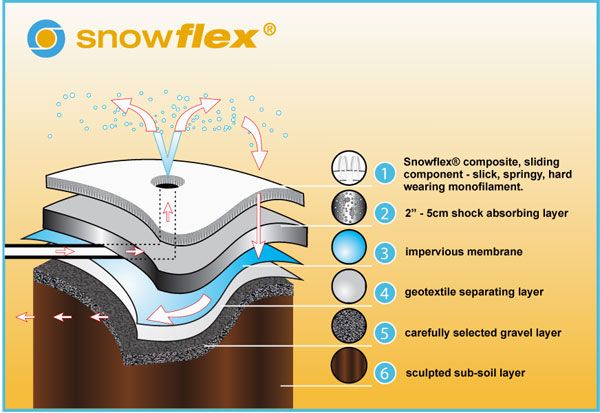What Even is Snowflex?
July 10, 2020
Written by Victoria Dissmore, Marketing Employee
Snowflex… The Liberty Mountain Snowflex Centre. You may have gone up for a fun event, or to go tubing, or to jump on the trampoline. But if you’ve ever skied or snowboarded or even sledded on the eponymous white carpet-y material, you may have wondered, what even is Snowflex?
Snowflex is…
According to the official website of the company that invented the artificial snow surface, Snowflex is made up of six layers from top to bottom:
- Snowflex composite, sliding component—slick, springy, hard wearing monofilament
- 2 in.–5 cm. shock absorbing layer
- Impervious membrane
- Geotextile separating layer
- Carefully selected gravel layer
- Sculpted sub-soil layer
Let’s Break That Down
If you’re like me, you have no idea what a lot of these mean. Thankfully, the Internet is a helpful and easily accessible resource for deciphering some of the more technical terms.
Polymer Composite
The Snowflex composite is made of a material called a polymer composite, which is “a multi-phase material in which reinforcing fillers are integrated with a polymer matrix, resulting in synergistic mechanical properties that cannot be achieved from either component alone.”[1]
Basically, this material is a large number of similar units bonded together at the molecular level (that’s a polymer) that are then mixed with another material (making the composite). All this is made into a monofilament, which is simply a single strand of the man-made fiber, comprised of that polymer composite.
Shock Absorbing Layer
It is unclear what exactly this shock absorbing layer is made of, as there are many materials available for shock absorption, but I would imagine it is some kind of foam material, to cushion the slope.
Impervious Membrane
The impervious membrane is a thin material that water cannot get through, so the water from the BritonMist lubrication system stays on the top layers and keeps the ground below from becoming too water-saturated.
This membrane is also used for recycling water that keeps the slope slick. When the water from the BritonMist system is sprayed onto the slope, it runs down onto the membrane and back to the piping mechanism to be reused on the slope.
Geotextile
A geotextile is a type of permeable fabric that helps separate, filter, reinforce, protect, and drain the soil beneath it. The geotextiles used for Snowflex make up a woven layer that helps prevent earth movement as people ski and snowboard on it. This is better for the environment because it creates limited disturbance, so the soil stays healthy.
Gravel Layer
The carefully selected gravel layer works with the geotextile layer to provide texture to the soil which prevents sliding and erosion.
Sculpted Subsoil Layer
The sculpted subsoil layer determines the lay of the land for the slope, including hills, bumps, and curves.
In Simpler Terms
If that explanation was still so much more than you ever wanted to know about your favorite artificial snow surface, here are the (very basic) basics. From top to bottom, Snowflex is made of:
- White carpet
- Foam
- Stuff that keeps water in upper layers
- Woven fabric
- Gravel
- Soil
Benefits of Snowflex
There have been many ski surface inventions over the last fifty years, but Snowflex is recognized as the artificial snow surface that is the closest replication of snow. Previous synthetic materials came out of the brush, plastic, or carpet industry, but Snowflex was designed specifically for skiers and snowboarders.
Besides the obvious benefits of year-round usability and the ability to be built anywhere, Snowflex has many other perks:
- Low carbon footprint compared to a refrigerated building
- Softer to fall on than hard packed snow
- Slopes can be built on land that might otherwise be unusable for building
- Maximum forward speed and extra edge control for turning
- Ability to create adventurous and interesting terrain and stunt formations
Fun Facts
In case you’re still curious about this mystery material on the mountain, here are three more fun facts about Snowflex:
- Must be installed by the company that designed and manufactured it (Briton Engineering Developments Ltd—they’re British!)
- Suggested replacement time about every ten years
- BritonMist water spraying system mists water at a particular droplet size, giving maximum effect with minimum water usage
Now you can impress all your friends with your hi-tech knowledge of Snowflex! And of course you have to come visit to check it out yourself!

